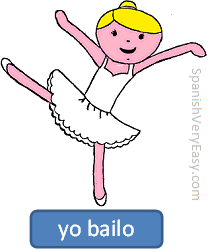
Present in Spanish

The name of this tense in Spanish is: "presente simple del indicativo".
Present Conjugation
In Spanish there are 3 types of regular verbs ("ar", "er" and "ir" verbs). Each type has a different conjugation. But don't worry we will explain you.
First Conjugation "-ar"
Next, we study the conjugation of the verb "cantar", the other Verbs ending in "-ar" follow the same conjugation table:
cantar (to sing)
| First conjugation [stem] + "-ar" | Meaning |
|---|---|
| yo canto | I sing |
| tú cantas | you sing |
| él canta | he sings |
| nosotros cantamos | we sing |
| vosotros cantáis | you sing |
| ellos cantan | they sing |
Second Conjugation "-er"
The conjugation of the "er" verbs is not very different, only changes the vowal "a" to "e", as example we will see the verb "beber":
beber (to drink)
| Second conjugation [stem] + "-er" | Meaning |
|---|---|
| yo bebo | I drink |
| tú bebes | you drink |
| él bebe | he drinks |
| nosotros bebemos | we drink |
| vosotros bebéis | you drink |
| ellos beben | they drink |
Third Conjugation "-ir"
The conjugation of the "ir" verbs is the most difficult, but come on!, you can learn it:
vivir (to live)
| Second conjugation [stem] + "-ir" | Meaning |
|---|---|
| yo vivo | I live |
| tú vives | you live |
| él vive | he lives |
| nosotros vivimos | we live |
| vosotros vivís | you live |
| ellos viven | they live |
Summary of 'present tense' endings
Next, we will show you a table with the endings of the 3 for you with all of the first, second and third person conjugations of regular verbs in the present indicative.
| Pronoun | first conjugation [stem] + "-ar" | second conjugation [stem] + "-er" | third conjugation [stem] + "-ir" |
|---|---|---|---|
| yo | -o | -o | -o |
| tú | -as | -es | -es |
| él ella usted | -a | -e | -e |
| nosotros nosotras | -amos | -emos | -imos |
| vosotros vosotras | -ais | -eis | -ís |
| ellos ellas ustedes | -an | -en | -en |
Uses of the present indicative
In Spanish, the present tense is used in the following cases:
- When speakers give, ask for or get information relating to present time
Lucía trabaja mucho en casa
Lucía works a lot at homeMaría vive en Madrid
María lives in Madrid - When actions that are currently taking place are described
Lucía lleva un abrigo muy bonito
Lucía is wearing a very nice coat¡Mira!, María camina muy deprisa
Look!, María is walking very fast - When we talk about universal laws or general truths
La tierra es redonda
The earth is roundViajar abre tu mente
Travel opens your mind - When we are talking about something that is done habitually
Los viernes voy a clases de natación
On Fridays I go to swim lessonsTodos los jueves como paella
Every Thursday I eat paella - When talking about the near future (something that is already known about) using temporal adverbs
¿Quedamos el viernes a comer?
So we´ll go for lunch on Friday?Te recojo en la estación esta tarde
I´ll meet you in the station this afternoon - When instructions are given, for example, in a recipe
Se pone el fuego al máximo,
Put the heat on high,a continuación pelamos las cebollas y las cortamos en trozos pequeños
then peel the onions and cut them into small pieces - When making suggestions
¿No vas a la biblioteca a estudiar?
Aren´t you going to the library to study?¿Bajas la pelota y jugamos?
Will you bring the ball down to play? - When asking for advice or favors
¿Me pongo la falda o (me pongo) el pantalón?
Which one will I put on, the skirt or the pants?¿Me ayudas con las matemáticas?
Will you help me with math? - When we offer our help
¿Te ayudo?
Can I help you?Mamá, ¿Bajo la basura?
Mom, should I throw out the trash?
The question with the present indicative
When we ask a question, generally, we switch the position of the verb to that of the personal pronoun. This rule is applicable to the three conjugations.
| Affirmation | Interrogation |
|---|---|
| tú cantas you sing | ¿cantas (tú)? do you sing? |
| él come he eats | ¿come (él)? does he eat? |
Negation of the present indicative
To make the negative form, simply put the adverb "no" before the verb, or, in other words, to the left of the verb.
| Affirmation | Negation |
|---|---|
| yo quiero I want | yo no quiero I don't want |
| él corre he runs | él no corre he doesn't run |
In Spanish, if we know the personal pronoun in advance, it´s omitted in most cases, because it is implicit in the verb tense used to speak.
You can see more information about omitting the personal pronoun in the following link: Personal pronouns (Pronombres personales)